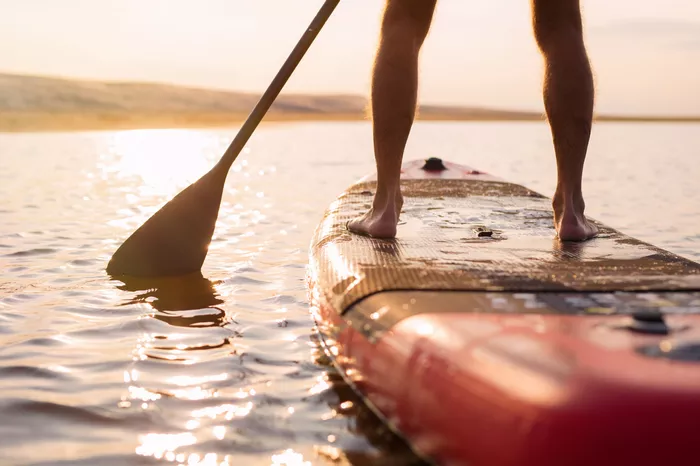Stand up paddle boarding (SUP) is an enjoyable outdoor activity that combines elements of surfing and kayaking. It’s perfect for exploring calm lakes, rivers, and ocean waves. This guide will cover everything you need to know to get started with SUP, from gear and techniques to safety tips.
What is Stand Up Paddle Boarding?
Stand up paddle boarding is a water sport where you stand on a large board and use a paddle to move across the water. It can be a relaxing way to enjoy nature or an intense workout, depending on how you choose to paddle.
Benefits of Stand Up Paddle Boarding
Full-Body Workout: SUP engages your core, arms, legs, and back.
Improves Balance: Standing on a board helps enhance your balance and stability.
Low Impact: It’s easier on your joints compared to running or high-impact sports.
Stress Relief: Being on the water promotes relaxation and mental clarity.
Choosing the Right Gear
1. Stand Up Paddle Board
Types of Boards:
- All-Around Boards: Versatile and stable, great for beginners.
- Touring Boards: Longer and designed for distance paddling.
- Surf Boards: Shorter and more maneuverable for waves.
- Inflatable Boards: Portable and easy to store, ideal for travel.
Length and Width:
- Length: Longer boards are faster, while shorter boards are more maneuverable.
- Width: Wider boards offer more stability, which is helpful for beginners.
2. Paddle
Material: Paddles can be made from aluminum, fiberglass, or carbon fiber.
Length: A good rule of thumb is to choose a paddle that is about 6-8 inches taller than you.
3. Safety Gear
Personal Flotation Device (PFD): Always wear a life jacket, especially in deeper waters.
Leash: A leash connects you to your board, preventing it from drifting away.
Sun Protection: Wear sunscreen, sunglasses, and a hat to protect against UV rays.
Preparing for Your First Paddle Board Experience
1. Find a Suitable Location
Look for calm, flat water that is free from strong currents and waves. Ideal spots include lakes, rivers, and sheltered bays. Avoid crowded areas or places with heavy boat traffic.
2. Check the Weather
Ensure that conditions are safe for paddling. Avoid windy days or storms, and check local weather reports for any warnings.
3. Gather Your Gear
Pack your paddle board, paddle, PFD, leash, and any additional safety gear. Consider bringing a water bottle, snacks, and a dry bag for valuables.
Getting on Your Board
1. Inflating Your Board (If Inflatable)
Follow the manufacturer’s instructions to inflate your board. Ensure it’s properly inflated to provide the right amount of support.
2. Launching from the Shore
Position the Board: Place your board in shallow water, with the nose pointing into the waves.
Get on the Board: Start on your knees in the center of the board. This position helps you balance as you get used to the movement.
3. Standing Up
Transition to Standing: Once you feel stable, place your hands on the board and slowly lift your knees. Stand up one foot at a time, keeping your feet shoulder-width apart.
Find Your Balance: Keep your knees slightly bent and your core engaged. Look forward, not down, to maintain balance.
Basic Paddling Techniques
1. Holding the Paddle
Grip: Hold the paddle with one hand on the top and the other on the shaft.
Angle: The blade should face away from you to maximize efficiency.
2. Paddling Forward
Strokes:
- Start the stroke by placing the paddle blade in the water near your feet.
- Pull the paddle back alongside the board, using your core for power.
- Exit the water when the paddle reaches your hips.
3. Turning
Forward Stroke: To turn right, paddle on the left side of the board.
Reverse Stroke: To turn left, paddle on the right side.
Sweep Stroke: For a wider turn, use a sweeping motion, reaching the paddle away from the board.
4. Stopping
To stop, place the paddle in the water and drag it behind you. This will slow down your momentum.
Advanced Techniques
1. Racing and Speed
Once you are comfortable, try to paddle faster. Focus on smooth, powerful strokes and maintain a steady rhythm.
2. Surfing Waves
For those interested in surfing, practice catching small waves. Position yourself just beyond the breaking point, paddle hard to catch the wave, and lean forward to maintain balance.
3. Yoga on SUP
SUP yoga is a great way to enhance your balance and core strength. Start with simple poses and gradually progress to more challenging ones.
Safety Tips for Stand Up Paddle Boarding
1. Know Your Limits
If you’re a beginner, stay close to shore and avoid deep water until you gain confidence.
2. Stay Aware of Your Surroundings
Watch for boats, swimmers, and changing weather conditions. Be mindful of currents and tides.
3. Practice Rescues
Falling off your board is common. Practice climbing back onto your board from the water. Stay calm and use your arms to help lift yourself back up.
4. Follow Local Regulations
Some areas have specific rules for paddle boarding. Check for any restrictions or guidelines before you launch.
Conclusion
Stand up paddle boarding is a fantastic way to enjoy the outdoors, improve your fitness, and have fun. With the right gear, basic techniques, and safety knowledge, you can confidently explore the water. Remember to practice regularly to build your skills and confidence. Happy paddling!
Related topics:
- How Swimming Affects the Body
- Best Fishing Jet Ski: The Ultimate Guide for Anglers
- How to Push Off the Wall in Swimming

